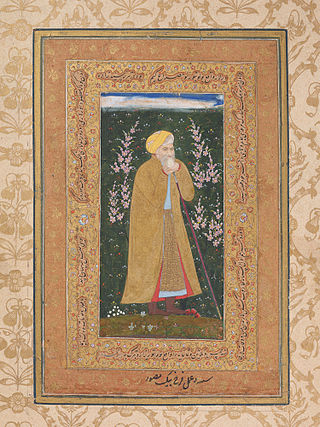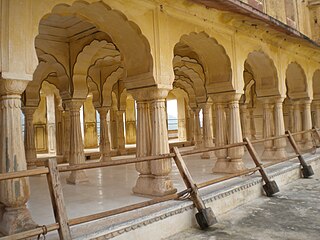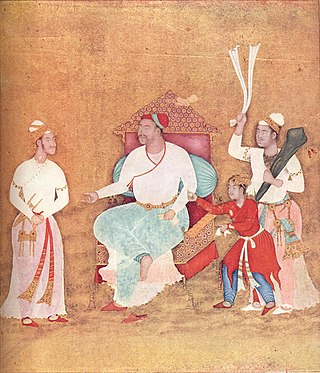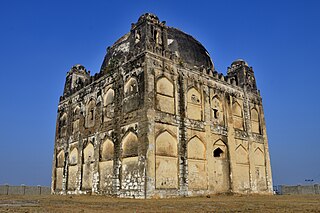Related Research Articles

Paper marbling is a method of aqueous surface design, which can produce patterns similar to smooth marble or other kinds of stone. The patterns are the result of color floated on either plain water or a viscous solution known as size, and then carefully transferred to an absorbent surface, such as paper or fabric. Through several centuries, people have applied marbled materials to a variety of surfaces. It is often employed as a writing surface for calligraphy, and especially book covers and endpapers in bookbinding and stationery. Part of its appeal is that each print is a unique monotype.

The Deccan sultanates were five late-medieval Indian kingdoms—on the Deccan Plateau between the Krishna River and the Vindhya Range—that were ruled by Muslim dynasties: namely Ahmadnagar, Berar, Bidar, Bijapur, and Golconda. The sultanates had become independent during the break-up of the Bahmani Sultanate. The five sultanates owed their existence to the declaration of independence of Ahmadnagar in 1490, followed by Bijapur and Berar in the same year. Golconda became independent in 1518, and Bidar in 1528.

Chhatri are semi-open, elevated, dome-shaped pavilions used as an element in Indo-Islamic architecture and Indian architecture. They are most commonly square, octagonal, and round. Originating as a canopy above tombs, they largely serve as decorative elements as opposed to functional elements. The earliest examples of chhatri being used in the Indian Subcontinent were found in the Shrine of Ibrahim in Bhadreswar, constructed between 1159 and 1175 AD.

Sahebzada Mir Himayat Ali Khan Siddiqi Azam Jah was the eldest son of the seventh and last nizam of Hyderabad, Mir Osman Ali Khan, Asaf Jah VII and Sahebzadi Azam unnisa Begum, daughter of Sahebzada Mir Jahangir Ali Khan Siddiqi.

Farrukh Beg, also known as Farrukh Husayn, was a Persian miniature painter, who spent a bulk of his career in Safavid Iran and Mughal India, praised by Mughal Emperor Jahangir as “unrivaled in the age.”
Ibrahim Adil Shah I was a Sultan and later Shah of the Indian kingdom of Bijapur. He succeeded his elder brother, Mallu Adil Shah, through the machinations of the Afaqi faction at the court. He was the first Adil Shahi ruler to assume the royal title of Shah.

The Toshakhana was a Mughal place where princes store "gifts and emblems of honor that they received for their posterity ... an archive of objects whose origin and receipt embodied his status and honor" The term is a word of Persian origin that literally translates into "treasure-house".

Salman Haidar is a former Indian diplomat who served as the Foreign Secretary of India. His tenure was from 1 March 1995 to 30 June 1997. He also served as high commissioner of India to the United Kingdom from January to July, 1998.

The Deccanis or Deccani People are an ethnoreligious community of Urdu-speaking Muslims who inhabit or are from the Deccan region of Central and Southern India, and speak the Deccani dialect. The community traces its origins to the shifting of the Delhi Sultanate's capital from Delhi to Daulatabad in 1327 during the reign of Muhammad bin Tughluq. Further ancestry can also be traced from immigrant Muslims referred to as Afaqis, also known as Pardesis who came from Central Asia, Iraq and Iran and had settled in the Deccan region during the Bahmani Sultanate (1347). The migration of Muslim Hindavi-speaking people to the Deccan and intermarriage with the local Hindus whom converted to Islam, led to the creation of a new community of Urdu-speaking Muslims, known as the Deccani, who would come to play an important role in the politics of the Deccan. Their language, Deccani Urdu, emerged as a language of linguistic prestige and culture during the Bahmani Sultanate, further evolving in the Deccan Sultanates.

Deccan painting or Deccani painting is the form of Indian miniature painting produced in the Deccan region of Central India, in the various Muslim capitals of the Deccan sultanates that emerged from the break-up of the Bahmani Sultanate by 1520. These were Bijapur, Golkonda, Ahmadnagar, Bidar, and Berar. The main period was between the late 16th century and the mid-17th, with something of a revival in the mid-18th century, by then centred on Hyderabad.
Pushkar Sohoni is an architect, and an architectural and cultural historian. He is an associate professor and the chair of the department of Humanities and Social Sciences at the Indian Institute of Science Education and Research, Pune.
Darya Imad Shah was the third Sultan of Berar. He reigned between 1530 and 1561.
The conversion of mosques into non-Islamic places of worship has occurred for centuries. The most prominent examples of such took place after and during the Reconquista.
The Shah Jahan Diamond mined from Kollur, Golconda—(currently Hyderabad, India). It is a hololithic flat, table cut 56 carat diamond, used as an amulet—(Tawid'th). In late 1600 AD Mughal Emperor Jahangir gifted it to Prince Shah Jahan—(by his name it is known). Currently it is owned by Dar al Athar al Islamiyyah, Kuwait.
Viceroy of the Deccan was the representative of the Mughal emperors in Deccan, Deccan consisted of six Mughal governorates (Subah): Khandesh, Bijapur, Berar, Aurangabad, Hyderabad and Bidar. Carnatic region was sub-Subah administered partly by governor of Bijapur and Hyderabad.
The conversion of non-Hindu places of worship into temples occurred for centuries, ever since the advent of other Dharmic faiths in the Indian subcontinent. As a result, Muslim mosques, Christian churches, Zoroastrian fire temples, Jain and Buddhist temples were converted into Hindu places of worship. Since the dawn of the 20th century, there is are active movement to convert non-Hindu religious sites into temples, primarily in the West and in India.

The Malik-E-Maidan also Malik-i-Maidan, is a 16th century cannon, located at Burj-E-Sherz, Bijapur Fort, Bijapur, India. 4.45 metres (14.6 ft) in length and cast in bell metal, it is the largest surviving block of artillery from medieval period.

The Gulshan-i 'Ishq is a romantic poem written in 1657 by the Indian Sufi poet Nusrati. Written in the Deccani language, it combines literary and cultural traditions from India and Iran. Manuscripts of the poem, illustrated with lavish paintings, have survived from the 18th century to the present day.
The Turquoise Throne or Takht-i-Firoza was a famous jewel-studded royal throne of the Bahmani Sultans of Deccan in India. It was a gift by Musunuri Kapaya Nayaka, then king of Warangal. Over a period of time, this throne became one of the most important icons of the Bahmani royalty and heritage.

Chor Gumbad, Kalaburagi is a domed building in Kalaburagi. It is listed as a state protected monument.
References
- 1 2 3 "Navina Najat Haidar Is Named Curator in Charge of Department of Islamic Art at The Met". The Metropolitan Museum of Art. 7 February 2020. Retrieved 12 March 2021.
- ↑ "Bernard Haykel | Department of Near Eastern Studies". nes.princeton.edu. Retrieved 12 March 2021.
- ↑ Sethi, Sunil (19 June 2015). "Lunch with BS: Navina Najat Haidar". Business Standard India. Retrieved 12 March 2021.
- ↑ Kazanjian, Dodie. "Navina Najat Haidar: The Magic Touch". Vogue. Retrieved 12 March 2021.
- ↑ "Sultans of Deccan India, 1500-1700: Opulence and Fantasy". Metropolitan Museum of Art . 20 April 2015.
- ↑ "Opulence and fantasy at the Met | Christie's". www.christies.com. Retrieved 12 March 2021.
- ↑ Wilkin, Karen (22 June 2015). "'Sultans of Deccan India, 1500-1700: Opulence and Fantasy' Review". Wall Street Journal. ISSN 0099-9660 . Retrieved 12 March 2021.
- ↑ Kennicott, Philip (8 May 2015). "At the Met, the artistic riches of India's Deccan Plateau". Washington Post. ISSN 0190-8286 . Retrieved 12 March 2021.
- ↑ Haidar, Navina; curator. "Opulent And Apolitical: The Art Of The Met's Islamic Galleries". NPR.org. Retrieved 12 March 2021.
- ↑ Smith, Roberta (23 April 2015). "Review: 'Sultans of Deccan India,' Unearthly Treasures of a Golden Age, at the Met (Published 2015)". The New York Times. ISSN 0362-4331 . Retrieved 12 March 2021.
- ↑ Puri, Anjali (28 March 2015). "A New York museum will celebrate Deccan sultanate's golden age". Business Standard India. Retrieved 12 March 2021.
- ↑ Tripathi, Shailaja (3 April 2017). "Museum of stories". The Hindu. ISSN 0971-751X . Retrieved 12 March 2021.
- ↑ P., Mahalakshmi (13 March 2007). "navina haidar: Great art refines the mind and uplifts the spirit: Navina Haidar - Times of India". The Times of India. Retrieved 12 March 2021.
- ↑ "New York's Metropolitan Museum of Art hosts exhibition on Deccan sultans jewellery". The Times of India. 25 June 2015. Retrieved 12 March 2021.
- ↑ Dalrymple, William. "The Renaissance of the Sultans". New York Review of Books. ISSN 0028-7504 . Retrieved 12 March 2021.
- ↑ "Books of the Year: authors on their favourite books of 2016". The New Statesman. 20 November 2016. Retrieved 20 May 2023.
- ↑ "Sultans of the Deccan 1500-1700". Metropolitan Museum of Art .
- ↑ "Divine Pleasures: Painting from India's Rajput Courts—The Kronos Collections". Metropolitan Museum of Art . 1 August 2016.
- ↑ "Divine Pleasures | Yale University Press". yalebooks.yale.edu. Retrieved 12 March 2021.
- ↑ Farago, Jason (14 July 2016). "'Divine Pleasures' Celebrates the Colors of Desire in Indian Paintings (Published 2016)". The New York Times. ISSN 0362-4331 . Retrieved 12 March 2021.
- ↑ Dobrzynski, Judith H. (31 May 2016). "Rajput Paintings at the Met". Wall Street Journal. ISSN 0099-9660 . Retrieved 12 March 2021.
- ↑ "Jerry Saltz on the Met's new galleries of Near Eastern art - artnet Magazine". www.artnet.com. Retrieved 12 March 2021.
- ↑ Cotter, Holland (27 October 2011). "A Cosmopolitan Trove of Exotic Beauty (Published 2011)". The New York Times. ISSN 0362-4331 . Retrieved 12 March 2021.
- ↑ Haidar, Navina Najat (31 October 2015). "Ramayana, with a Mughal brush". The Hindu. ISSN 0971-751X . Retrieved 12 March 2021.
- ↑ Haidar, Navina Najat. "Reimagining the Mughals". www.newsweekpakistan.com. Retrieved 12 March 2021.
- ↑ Haidar, Navina Najat; Sardar, Marika (13 April 2015). Sultans of Deccan India, 1500–1700: Opulence and Fantasy. Metropolitan Museum of Art. ISBN 978-0-300-21110-8.
- ↑ Haidar, Navina Najat; Stewart, Courtney Ann (27 October 2014). Treasures from India: Jewels from the Al-Thani Collection. Metropolitan Museum of Art. ISBN 978-0-300-20887-0.
- ↑ Alteveer, Ian; Haidar, Navina Najat; Wagstaff, Sheena (2013). Imran Qureshi: The Roof Garden Commission. Metropolitan Museum of Art. ISBN 978-1-58839-519-1.
- ↑ Haidar, Navina Najat; Weisbin, Kendra (2013). Islamic Art in the Metropolitan Museum of Art: A Walking Guide. Metropolitan Museum of Art. ISBN 978-1-85759-827-8.
- ↑ Haidar, Navina Najat; Sardar, Marika (2011). Sultans of the South: Arts of India's Deccan Courts, 1323-1687. Metropolitan Museum of Art. ISBN 978-1-58839-438-5.
- ↑ Haidar, Navina Najat (1995). The Kishangarh School of Painting, C.1680-1850. University of Oxford.